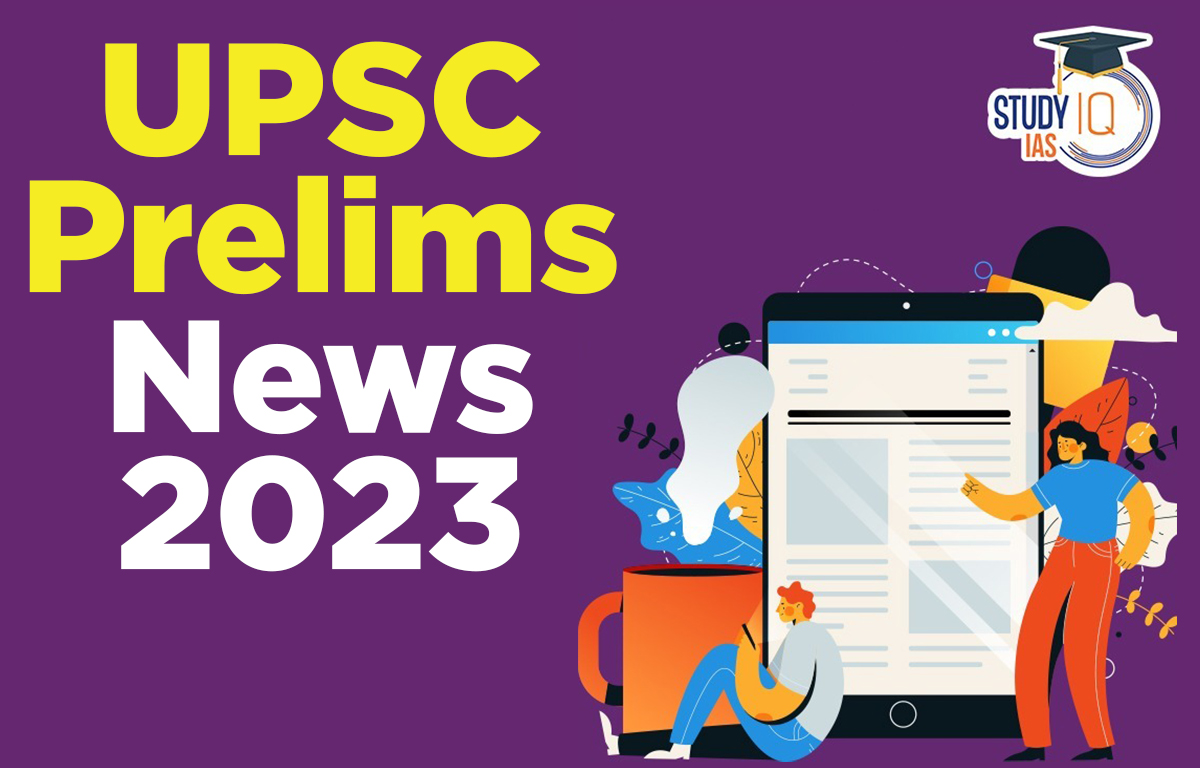UPSC Prelims News of 4 February 2023
Sickle Cell Disease
Context: The government of India, under the National Health Mission, supports the states for the prevention and management of sickle cell disease.
About Sickle Cell Disease (SCD)
- Sickle cell disease (SCD) is a chronic single-gene disorder characterized by chronic anaemia, acute painful episodes, organ infarction and chronic organ damage and a significant reduction in life expectancy.
- Occurrence:
- SCD is a genetic condition that is present at birth. It is inherited when a child obtains two genes that code for abnormal haemoglobin.
- Effects:
- In patients with SCD, abnormal haemoglobin causes the red blood cells to become hard and sticky and take a “sickle” shape.
- The sickle cells die early, which creates a shortage of red blood cells. They get stuck and clog the blood flow while travelling through small blood vessels.
- This can cause pain and other serious health complications such as infection, acute chest syndrome and stroke.
- Treatment:
- The only therapy that may be able to cure SCD is a bone marrow or stem cell transplant.
- For the transplant to succeed, the bone marrow must be a close match, usually from a sibling.
- Tackling SCD:
- The union budget of FY 2023-24 has announced a mission to eliminate sickle cell anaemia by 2047.
- The mission focuses on awareness creation, universal screening of people in the 0-40 years age group in affected tribal areas and counselling through collaborative efforts by both state and union governments.
- The government of Madhya Pradesh has established Integrated Centre for Hemophilia and Hemoglobinopathies in 22 Tribal District for the treatment and diagnosis of patients.
Joint Parliamentary Committee
Context: Opposition parties have demanded Joint Parliamentary Committee (JPC) probe into the allegations of fraud and stock manipulation against the Adani Group.
About
- A Joint Parliamentary Committee (JPC) is set up by the Parliament for a special purpose, especially for the detailed scrutiny of a subject or Bill.
- JPC has members from both Houses and includes both the ruling party and the opposition party members. It is dissolved after the end of its term or completion of the task.
- Procedure for setting up:
- A JPC comes into existence after one House of Parliament has passed a motion and the other has agreed to it.
- Members of the JPC are decided by the Parliament and the numbers can vary – there is no fixed number.
- Functions:
- The JPC’s mandate depends on the motion constituting it. It can scrutinize documents and summon people for questioning to fulfil its mandate.
- After finishing its task, JPC submits a report and makes recommendations to the government.
- Powers:
- JPC’s recommendations have persuasive value, but they are not binding on the government.
- The government can choose to launch further investigations based on the JPC report, but it can’t be forced to do so.
- However, the government is required to submit report on the follow-up action taken on the basis of the recommendations of the JPC.
- Previous instances of setting JPCs:
- JPC to examine matters relating to the Allocation and Pricing of Telecom Licenses and Spectrum;
- JPC on Pesticide Residues in and Safety Standard for Soft Drinks, Fruit Juice and other Beverages;
- JPC on Stock Market Scam and Matters Relating thereto etc.
Indian Semiconductor Mission
Context: India Semiconductor Mission (ISM) has been set up to formulate and drive India’s long-term strategies for developing semiconductors and display manufacturing facilities and the semiconductor design ecosystem.
About India Semiconductor Mission
- ISM will serve as the nodal agency for efficient, coherent and smooth implementation of the programme for the development of the semiconductor and manufacturing ecosystem in India.
- It will be led by global experts in the Semiconductor and Display industry.
- Objectives of ISM include:
- Formulate a comprehensive long-term strategy for developing sustainable semiconductors and display manufacturing facilities and semiconductor design eco-system in the country in consultation with the Government ministries/departments/agencies, industry, and academia.
- Facilitate the adoption of secure microelectronics and develop a trusted semiconductor supply chain, including raw materials, speciality chemicals, gases, and manufacturing equipment.
- Enable a multi-fold growth of the Indian semiconductor design industry by providing requisite support.
- Promote and facilitate indigenous Intellectual Property (IP) generation.
- Establish suitable mechanisms to harness economies of scale in the Indian semiconductor and display industry.
- Enable collaborations and partnership programs with respective stakeholders.
- Further, ISM has been working as the nodal agency for the Schemes approved under Semicon India Programme.
Generative Artificial Intelligence
Context: There are rising applications and ethical concerns in Generative Artificial Intelligence (AI).
About:
- It is a cutting-edge technological advancement type of artificial intelligence that involves creating new, original content or data using machine learning algorithms.
- It can be used to generate text, images, music, or other types of media.
- Generative AI works by training a model on a large dataset and then using that model to generate new, previously unseen content that is similar to the training data.
- This can be done through techniques such as:
- Neural machine translation
- Image generation
- Music Generation
- Application: Generative AI has applications in sectors like education, manufacturing, healthcare, finance, and others.
Cholera
Context: Africa’s public health agency has said that countries with deadly cholera outbreaks on the continent have no “immediate access” to vaccines amid a global supply shortage.
About Cholera:
- Cholera is an acute diarrhoeal infection caused by the ingestion of food or water contaminated with the bacterium Vibrio cholerae.
- The infection is often mild or without symptoms, but sometimes can be severe.
- Symptoms: The symptoms include Profuse watery diarrhoea, Vomiting, Leg cramps etc.
- Transmission: A person may get cholera by drinking water or eating food contaminated with the cholera bacterium.
- The disease can spread rapidly in areas with inadequate treatment of sewage and drinking water.
- Vaccine: Currently there are three WHO pre-qualified oral cholera vaccines (OCV), Dukoral, Shanchol, and Euvichol-Plus.
- All three vaccines require two doses for full protection.
- The disease remains a global threat to public health and an indicator of inequity and lack of social development.
- A multifaceted approach is key to controlling cholera and reducing deaths. A combination of surveillance, water, sanitation and hygiene, social mobilisation, treatment, and oral cholera vaccines are used.
Red Sanders
Context: The Convention on International Trade in Endangered Species of Wild Fauna and Flora (CITES) recorded 28 incidents of confiscation and seizure of more than 19,049 tonnes of Red Sanders logs.
About Red Sanders
- Red Sanders (Pterocarpus santalinus) is a flora species that is endemic to a distinct tract of forests in the Eastern Ghats region of Andhra Pradesh.
- It falls under ‘endangered list’ in the International Union for Conservation of Nature (IUCN) Red List.
- Red Sanders is also listed in Appendix II of the Convention on International Trade in Endangered Species of Wildlife Fauna and Flora (CITES) and Schedule II of the Wildlife Protection Act, 1972.
- Threats:
- Illicit felling for smuggling, forest fires, cattle grazing and other anthropogenic threats.
- Red Sanders, known for their rich hue and therapeutic properties, are high in demand across Asia, particularly in China and Japan, for use in cosmetics and medicinal products as well as for making furniture, woodcraft and musical instruments.
- The export of Red Sanders from India is prohibited as per the Foreign Trade Policy.
Sagar Parikrama
Context: The Department of Fisheries, has launched the ‘Sagar Parikrama’ program on the occasion of 75th Azadi Ka Amrit Mahotsav.
About Sagar Parikrama:
- The Sagar Parikrama program is being organized through a pre-decided sea route covering coastal states/UTs.
- The main objectives of ‘Sagar Parikrama’ are
- to facilitate interaction with fishermen, coastal communities and stakeholders so as to disseminate information on various fisheries-related schemes and programs being implemented by the Government;
- demonstrating solidarity with all fisher folk, fish farmers and concerned stakeholder as a spirit of Aatmanirbhar Bharat;
- to promote responsible fisheries with a focus on the sustainable balance between the utilization of marine fisheries resources for the food security of the nation and the livelihoods of coastal fisher communities and
- protection of marine ecosystems.
- The interaction programs organized during the ‘Sagar Parikrama’ aims to resolve the issues of the fishers and facilitate their economic upliftment through various fisheries schemes and programs such as
- ‘Pradhan Mantri Matsya Sampada Yojana’ (PMMSY)
- ‘Fisheries and Aquaculture Infrastructure Development Fund’ (FIDF) that provides concessional finance to eligible entities, and
- the facility of Kisan Credit Card (KCC) which has been extended for fishers and fish farmers since 2018-19.
Polymetallic Nodules
Context: In the Union Budget 2023-2024, the Deep Ocean Mission was announced with an outlay of 600 crores, one of whose objectives is to mine and extract polymetallic nodules (PMNs).
About the Polymetallic Nodules (PMNs)
- Polymetallic nodules, also known as manganese nodules, are small, potato-shaped, rock-like structures found on the ocean floor.
- Composition: They contain valuable metals such as nickel, cobalt, manganese, copper, and iron, as well as other rare earth elements.
- Formation: These nodules form over millions of years as minerals precipitate around a central core, usually a fragment of volcanic rock.
- Distribution: They are found in vast quantities on the deep-sea floor, covering vast areas of the Pacific, Indian, and Atlantic Oceans.
- Significance: The extraction of valuable minerals from polymetallic nodules is a growing area of interest for the mining industry, as demand for these metals continues to rise.
- India and Polymetallic Nodules:
- India signed a 15-year contract for the exploration of Polymetallic Nodules in CIOB with the International Seabed Authority in 2002.
- In 2016, India got an extension of this contract up to 2022.


 UPSC Prelims News 20 March 2023
UPSC Prelims News 20 March 2023
 UPSC Prelims News 17 March 2023
UPSC Prelims News 17 March 2023





















